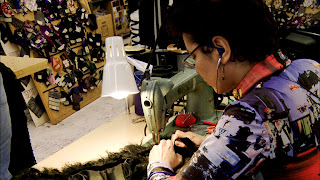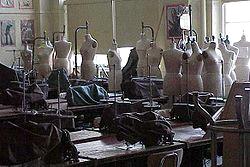To make your pants you’ll need the following:
• A pair of pajama pants or jeans that fit you just right.
• Two pieces of fabric. They need to be 5" taller than your pants and 2" wider than your pants.
• Measuring tape
• Chalk
• Scissors
• Sewing machine or sewing kit
A drawstring or strip of elastic
Step 1. Fold your pants in half, pulling out the crotch seam so that they are completely flat. Make sure that you can see the seam all the way from the ankle to waist on both sides.

Step2. Fold your fabric in half, wrong-side out. Lay your pants on the fabric so that the outer seam is lined up with the fold. It is okay if the pants are curved and don't line up perfectly with the fold.
Use your chalk to trace around the edge of your pants. Leave 2" below the ankle and above the waist to allow for hemming. Stay 1/2" away from the edges the rest of the way around.
Repeat this step to make the other side of your pants. Cut each piece around the chalk line. Do not cut the fold of the fabric.

Step3. Remember, your fabric should be wrong side out. Start at the crotch and straight stitch all the way to the ankle. Repeat on the other side.
Before you continue, it is important that you zigzag stitch the raw edges. This will keep your pants from unraveling in the washer. It might seem trivial now, but you do not want to skip this bit.

Step4. Start at the bottom front of the crotch where the legs meet. Straight stitch from the point up to the waistline. Repeat with the back of the pants, starting at the bottom and stitching to the waist.
Zigzag stitch the raw edges from front to back.
Next, you'll need to add buttonholes for a drawstring, or measure elastic for an elastic waistband.

Step5. Drawstring: On the front of your pants, measure two inches from the top of the waistline to the center seam. Mark this point. Measure a 1 1/2" out from this point to the right and left. Mark a 1" vertical line on each side, as shown. There should be 3" between each line, and they should be the same distance from the center seam.
Use a buttonhole stitch or the buttonhole setting on your sewing machine to stitch along the vertical chalk lines.
Elastic: For an elastic drawstring, measure around your waist with the measuring tape. Cut a strip of elastic at this length. We will insert it in the next step.

Step6. Zigzag stitch all along the raw waistline.
Fold down the waist 2" to hem. If you put on buttonholes, make sure that you are stitching below these. Straight stitch all the way across. Thread your drawstring easily by attaching a safety pin to the end.
If you are inserting an elastic waistband, straight stitch all the way around until you are 2" from your starting point, leaving an opening to insert the elastic. Use a safety pin to thread your elastic through the opening and all around the waist. Stitch the elastic ends together. Finish stitching the waist closed.
Finally, all you need to do is hem the bottom.

Step7. Turn your pants inside out and try them on. decide how long you want the pants to be. This is the point where you could chop the legs and make Capri's or shorts at the last minute.
Zigzag the stitch the raw edges of the ankles. Fold in and pin the bottom hem where you want it. Take off the pants and turn them inside out again.
Straight stitch along the hem, a 1/2" away from where your raw edge is. You can also stitch along the bottom of the hem for a finished look. Make sure that you are evenly stitching all the way around the leg 
































